by Fi Jordan, Senior Ceramics Conservator, and Dana Melchar, Senior Furniture Conservator
The conservation of an early seventeenth-century virginal (402-1872) for the Europe 1600-1800 Galleries provided an opportunity for the sharing and development of skills within the V&A Objects Conservation Section (Figure 1). The virginal is composed of materials – wood, leather, glass, enamel and various metals – that fall under the care of furniture, metal and glass conservators. The rectangular, integral wooden case is covered with brown leather embellished with gold. The inside of the case and instrument are decorated with glass, thin enamelled metal plates, brass strings, tightly-spiralled hitch pin loops and tuning pins. The double-hinged lid has eighteen panels of elaborate lamp-worked glass figurative scenes depicting Ovid’s Metamorphoses.
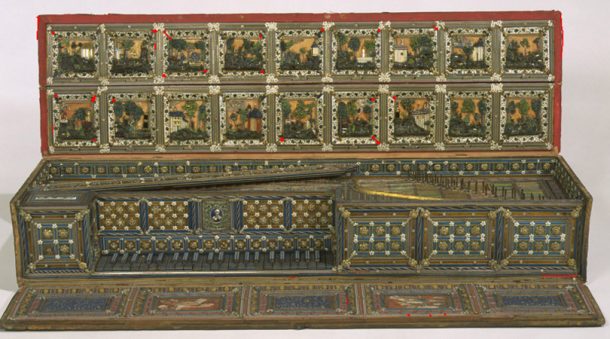
Lamp-working glass is a technique of shaping a small bead of glass with localised heat from an oil or spirit lamp that allows for detail on a minute scale. Different colours added to the bead are fused in place to build up the required relief decoration. There are further decorative glass elements incorporated on almost all the exposed wooden elements, including the keys and soundboard, arranged as a grid of coloured strips or finely twisted rods with gilded rosettes and flowers.
The virginal has a history of restorations. The structure was assessed to be in a fairly stable condition; however, the leather was lifting from the case exterior and many of the glass and metal features were poorly adhered or detached and fragmented. Major damage to lamp-worked glass components put them at risk of further damage and loss. Conservators and curators involved in the decision-making process considered treatment options, not only in relation to the object’s physical stability, but also in terms of its context and presentation within the gallery. An essential part of the early decision-making process was deciding on a treatment achievable in time for the gallery installation. It was estimated that most of the conservators’ time needed to be devoted to stabilising the figurative panels and their enamel and glass borders.
Treatment began with stabilisation of the leather covering the case. It was surface cleaned with a soft brush and a Saugwunder suction block sponge. Lifting leather was re-adhered with a mixture of Lascaux 360 HV & 498 HV acrylic emulsions (2:1). Once the exterior was secure, a multi-stage treatment began on the decorative interior: cleaning, improving disfiguring or failing repairs, re-adhering detached elements and casting missing ornamentation.
Surface dirt that had collected on all elements over the years was removed with a soft brush and, where appropriate, low-suction vacuum. Cotton wool swabs dampened in deionised water and industrial methylated spirit (50:50 solution) were rolled over the glass surfaces to lift off disfiguring loose dirt. Occasionally, mechanical methods were needed to remove old adhesive. Donna Stevens, Senior Metals Conservator, gave guidance on how best to treat the enamel decoration. Fragile enamel flaking from the metal substrate was consolidated with Paraloid™ B72 in xylene (15% solution w/v) prior to cleaning with a saliva-dampened swab.
On the figurative panels, previous repairs utilising paper and wax as gap-fillers for areas of lost scenery required stabilising in situ. Lascaux 360 acrylic emulsion diluted in deionised water was introduced by syringe. Time was spent sifting through the large amount of detached glass fragments and re-adhering elements to the panels where possible. Heads, limbs, buildings, foliage and animals were able to be reintroduced to the panels, making the scenes much more legible. In some instances, old repairs were dismantled where joins had been positioned incorrectly. Fragments were bonded with Paraloid™ B72 in acetone (<20% solution w/v).
The final stage of the project was the replication of missing glass border elements that visually impacted the interpretation of the instrument. Mould-making and casting missing sections are time-consuming processes. As time resources were limited, rather than opting for the fine detail obtainable from a slow setting, two-part silicon rubber mould, an alternative easy to use, quick-setting impression material (Steramould® kneadable putty) was pressed around existing rods and rosette shapes. Prior to its application, a barrier layer of Paraloid™ B72 in acetone (<3% w/v) protected the delicate surface decoration. Coloured casts were made from the addition of pigment dyes to a low-viscosity epoxy resin (Hxtal NYL-1) chosen for its compatibility, colour stability and translucency (Figure 2).
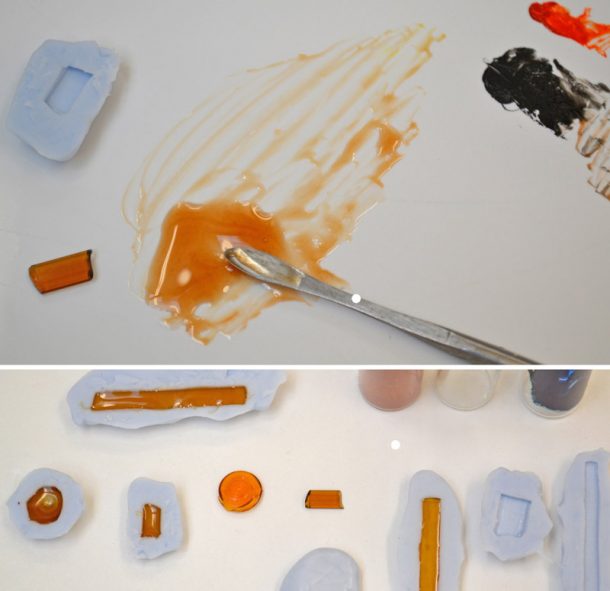
Small amounts of intense pigment dye colours in paste form (Ciba-Geigy Orasol®) were mixed in the epoxy. It was left to settle, allowing the dye to dissolve and produce an even, transparent colour, before reviewing the density and colour match in transmitted light. Once cured, a small degree of shaping was possible without removing the clear gloss finish. Further decoration was applied by hand (Figure 3).
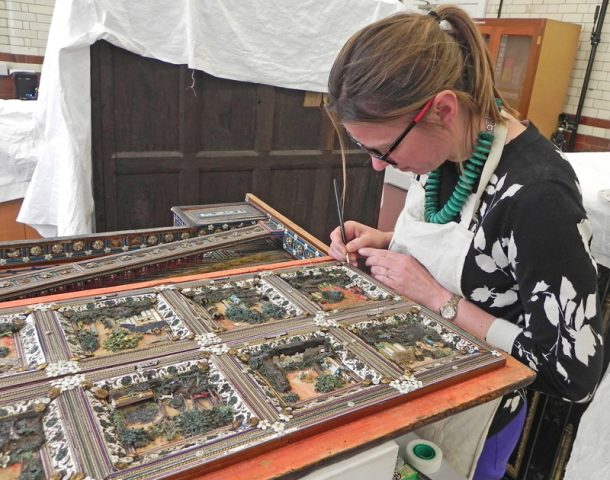
The expectations and wishes of the conservators, and where best to utilise and expand areas of expertise, were identified at the start of the collaboration. The project brief allowed the conservators to set themselves tasks that could be worked on independently, making good use of the available time. Specialist practical skills were used to best advantage, ensuring an efficient and cost-effective delivery of the project. For instance, the furniture conservator’s archaeological approach to the sorting of minute fragments preceded the glass conservator’s decisions on which were the most suitable to reattach. Finite resources dictated the amount of time dedicated to finding the minutest fragments for reattachment without putting the glass panels at risk of further damage. Glass not re-adhered has been labelled and stored. The team worked together when two pairs of hands were needed, such as the positioning of the broken ends of a thin lamp-worked thread of glass.
The virginal is stable for display and gap-fills were restricted to key areas (Figures 1, 4 and 5) with the overall aim of enhancing the viewer’s enjoyment and understanding of the piece. The team worked closely to make informed judgements and, in turn, gained valuable experience during the treatment. Discussions on ethical considerations, studio practices, and materials and techniques undertaken by different disciplines added to the success of the skills sharing.
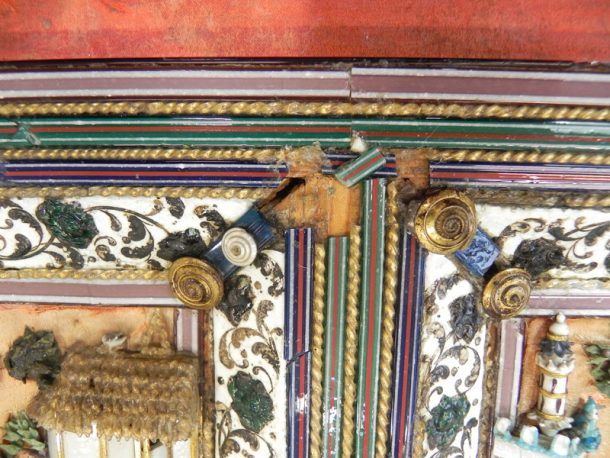
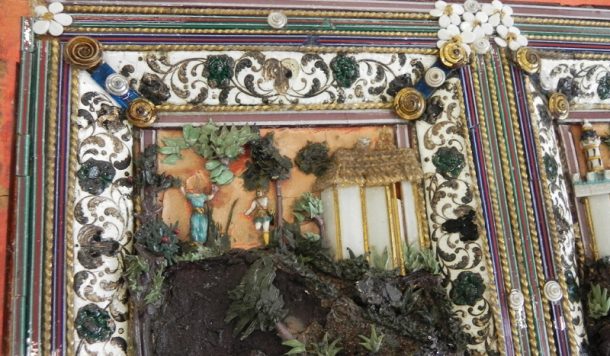
Europe 1600-1815 has been made possible thanks to the generosity of the Heritage Lottery Fund, the children of Her Highness Sheikha Amna Bint Mohammed Al Thani, the Friends of the V&A, The Selz Foundation, Würth Group, The Wolfson Foundation, Dr Genevieve Davies, William Loschert, the J Paul Getty Jr Charitable Trust and many other private individuals and trusts.


